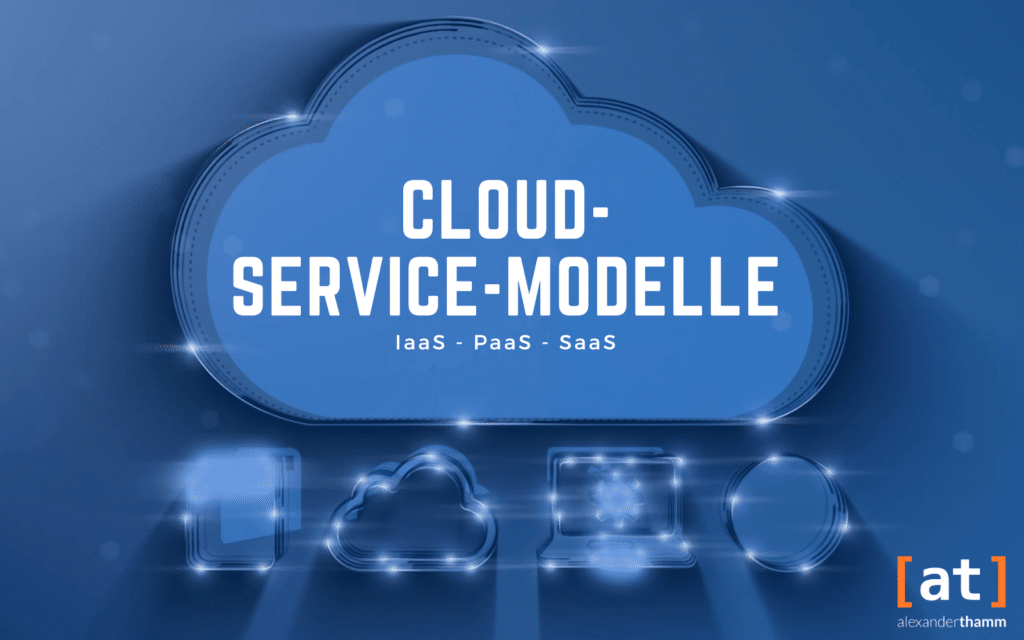Cloud transformation is the key to unlocking flexibility, scalability and innovation for your organisation. According to Gartner, the move to the cloud will consume around 1.8 trillion dollars in corporate IT spending by 2025. It's a revolutionary technology that will help your organisation stand out from the competition. However, there is a lack of clarity about "why" an organisation should consider adopting the cloud and "what" the cloud transformation process looks like. In this blog post, we will therefore look at the value of cloud transformation and show you how you can move your organisation forward.
Inhaltsverzeichnis
Cloud transformation and related concepts
Cloud refers to the servers that are accessed via the Internet and includes the software and Databasesrunning on the servers. In the cloud transformation, companies are moving their Applications and services from local servers to the cloud. This is a lengthy process that requires the Migration of applications and software programmesThe IT infrastructure is being reorganised, company data is being moved to the cloud and the IT infrastructure is being restructured.
The introduction of cloud transformation is a major challenge for every company. massive strategic change, the performance of the Cloud computing to accelerate the company's digital transformation goals. Cloud-based digital transformation is the lifeline of every modern organisation on the road to innovation.
The digital transformation refers to small or large Companies that use digital technologiesto accelerate their business processes and improve the customer experience in response to changing market demands. It's a bold move that involves overhauling your business model and developing a strategy to utilise digital tools and thinking. The process can include everything from automated workflows that are artificial intelligence to improving the customer experience through mobile apps.
The Digital transformation with cloud technology enables organisations to harness the immense power and potential of the cloud to improve their drive forward and accelerate the transformation process. The process fundamentally changes the way an organisation works. The entire system becomes robust when combined with a strong change management strategy. So while digital transformation defines the future state of an organisation, which may include moving to the cloud, a comprehensive Change management strategy the timetable for smooth navigation along this route.

Find out in our blog post how a comprehensive cloud strategy helps companies to achieve long-term goals and realise the full potential of the cloud
Cloud strategy: why companies need it and how to implement it
Advantages of the cloud transformation
Cloud transformation protects companies from market threats. It prevents companies from becoming obsolete by helping them to remain competitive and adapt quickly. The shift of the Working in the cloud enables companies to adopt digital technologies quickly. A successful cloud transformation supports long-term strategic business plans and accelerates day-to-day business operations. As cloud transformation offers so many benefits for organisations, here is a list of the key advantages of this technology:
- Improved scalabilityBy customising cloud transformation, companies can scale up or down their operations as needed, respond quickly to requirements and start new projects without having to spend time upgrading their IT infrastructure.
- Increased flexibility: Cloud data platforms offer various services and applications as well as the necessary tools and services to align and develop your organisation in response to strategic requirements.
- Improving cost efficiencyWhen you move your services to the cloud, you only pay for the services you use, resulting in cost efficiencies for your organisation.
- Exemplary innovationCloud service providers are updating their infrastructure with the latest features so that subscribers, such as businesses, can stay ahead of their competitors by utilising the latest tools and innovations.
- Seamless collaborationThe cloud enables real-time collaboration, regardless of an employee's location, which increases productivity.
- Comprehensive data securityCloud providers invest heavily in the Security to protect your company's data.
- High reliabilityCloud services offer an infrastructure with effective backup solutions, minimised downtimes and efficient recovery in the event of unforeseen technical failures and natural disasters.
- Ubiquitous global presenceCloud providers have an extensive network of data centres that form the basis for offering your business applications and services to your target group worldwide.

In our article on cloud service models, we inform you about the differences between the three different services - Infrastructure-as-a-Service (IaaS), Platform-as-a-Service (PaaS) and Software-as-a-Service (SaaS) - and the benefits for your company.
Cloud computing for digital transformation in companies
Digital transformation involves the use of modern technologies, such as cloud platforms, to create or change business processes in order to meet changing market requirements. It leads to fundamental changes in a company's processes, optimises internal resources and offers customers added value. The process helps to reshape business operations and development by enabling a company to move from physical data centres to modern cloud platforms to reduce deployment time, increase stability and bring new products to market faster. Cloud computing is the cornerstone of this transformation as it enables organisations to become more agile, collaborative and customer-centric.
Find out below how cloud functions promote operational excellence:
- Modernisation of the infrastructureThe Cloud infrastructure offers a flexible structure that enables companies to adapt quickly to market fluctuations. The infrastructure is also efficient and eliminates the need to manage underutilised hardware.
- Data managementCompanies can use the cloud providers' premium tools for sophisticated data analyses. The tools also help with the efficient management of huge amounts of data from different devices, sources and systems.
- Minimisation of operating costsThe introduction of cloud computing leads to a reduction in the budget previously spent on hardware and software on site. Companies only have to pay for the services they use. This frees up resources for other strategic initiatives.
- Breaking up team silosCloud-based applications accelerate collaboration across the organisation by sharing information in real time. The process helps to streamline operational workflows and improve project execution, leading to value-driven outcomes for clients.
However, every technology brings its own challenges, and cloud computing is no exception. Below you will therefore find some general Challenges in the use of cloud computing for operational digital transformation:
- Data security issuesAll companies must protect themselves against cyber security threats. Even though cloud services are offered with cyber threat protection, organisations are still responsible for the data they host in the cloud. Therefore, organisations should have their own cyber security strategy to protect themselves from unprecedented security threats.
- Lack of expertiseCloud services offer technology upgrades that meet the required changes in the market. However, organisations need to be aware that this process does not work as a standalone process. Therefore, companies need to cultivate cloud capabilities throughout the organisation.
- Challenges in complying with regulationsIf your company chooses a third-party cloud service provider, you must constantly ensure that they comply with the legal guidelines on data protection. This is necessary as your organisation will be held accountable if the third-party cloud service provider suffers a data breach.
- Challenging migration processCloud migration is a painstaking process where a lot can go wrong. For example, unexpected costs could arise due to errors in budget planning or you could suffer an outage due to inconsistencies between your legacy software and the cloud services. That's why it's important to plan ahead.

Discover how cloud migration transforms your business, maximises benefits and minimises risks - your guide to a more efficient organisation:
4 phases of the cloud transformation process
A carefully considered cloud transformation strategy is necessary to avoid downtime and data loss. Below is a suggested roadmap for building cloud transformation capacity in your organisation:
Phase 1: Exploration and evaluation
- Definition of business objectivesYour business goals should include the benchmarks you want to achieve through cloud transformation. Some examples of business goals include increasing efficiency, improving collaboration and improving customer service.
- Mapping the processYou need to critically evaluate and document your existing internal processes to identify inefficiencies and bottlenecks that need to be improved.
- Evaluation of your application portfolioIdentify and document the business owners for each of your applications. Once you have the list of owners, you can start to identify your tech stack, lifecycle stage, hosting type, technical suitability, functional suitability and business criticality.
- Develop a cloud strategyBased on your findings and the assessment of your business objectives, process mapping and portfolio evaluation, you choose the cloud deployment model that best fulfils your requirements.
Phase 2: Design and planning
- Evaluation of the cloud suitability of your applicationsOnce you know your current state, you can start planning your cloud transformation. Firstly, you need to select the applications you want to migrate and the cloud service you want to migrate them to.
- Identification of the best migration candidatesThis allows you to assess which applications you should migrate and which you should leave out. You can then prioritise the applications for cloud transformation based on business requirements and ease of migration.
- Development of a migration roadmapCreate a roadmap by defining the timeline for the migration. Ensure that the roadmap is detailed and accessible to employees in your organisation to ensure transparency and optimal collaboration.
- Strategy for change managementA comprehensive change management plan helps employees to seamlessly transition to the cloud-based process.
Phase 3: Implementation and optimisation
- Setting up the cloud infrastructureSet up your chosen cloud environment and take the necessary security measures.
- Migrate applications: Use your migration plan to identify the relevant applications and Data migrate to the cloud.
- Integration of processesEstablish a seamless data flow and process continuity by integrating the cloud-based applications into your company's existing systems.
- Employee trainingYour employees should be aware of the new changes in business operations. Train them on the new cloud-based tools and their benefits for them and your company.
Phase 4: Continuous improvement
- Performance monitoringYou need to define performance metrics that you can use to monitor the cloud environment. Some examples of such metrics are application uptime, network latency and resource utilisation.
- Optimisation of processesUse real-time data to identify opportunities to streamline and optimise process performance within the cloud environment.
- Security update: Implement the latest best practices for the Cloud security and carry out regular vulnerability assessments.
- Researching innovationTake advantage of the latest advances in cloud-based technologies that can enhance your business processes and create added value for your customers.
The cloud at the centre of operational digital transformation
Cloud transformation is a key strategy for companies that want to unleash innovation. By leveraging cloud-based digital transformation, companies can revolutionise their operations, improve the customer experience and create significant added value. However, for a successful transformation, it is essential to overcome the challenges associated with cloud computing, such as data security, expertise, compliance and migration. Therefore, it is essential for organisations to create a well-structured cloud transformation roadmap so that they can seamlessly manage this transformative journey and maximise the potential of cloud technology.











0 Kommentare